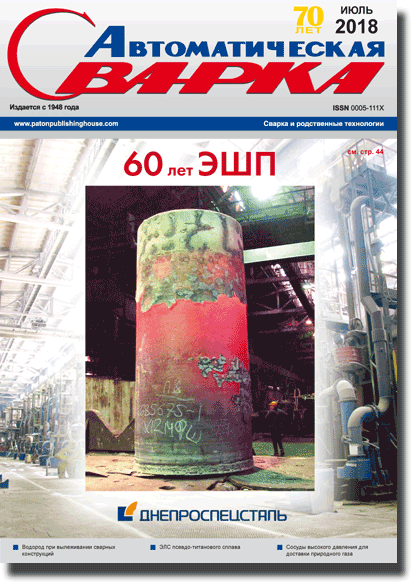| 2018 №07 (04) |
DOI of Article 10.15407/as2018.07.05 |
2018 №07 (06) |

Avtomaticheskaya Svarka (Automatic Welding), # 7, 2018, pp. 31-36
Possibilities of manufacturing three-layer welded honeycomb panels from aluminium alloys
L.V. Petrushynets, Yu.V. Falchenko, V.E. Fedorchuk, V.S. Shynkarenko
E.O.Paton Electric Welding Institute of the NAS of Ukraine, 11 Kazimir Malevich Str., 03150, Kyiv, Ukraine. E-mail: office@paton.kiev.ua
Three-layer honeycomb panels are widely applied in aircraft construction, ship-building, construction and others industries. In terms of design they consist of honeycomb core and two skins. At relatively small weight, these structures are characterized by high strength values, sound- and heat-insulating properties. The main problem in manufacturing a three-layer structure is welding the upper and lower skins to end faces of the honeycomb core. The work presents the results of development of the technology of manufacturing three-layer honeycomb panels of 150×150 mm size from aluminium alloys. The honeycomb core from AD1 aluminium alloy 0.150 mm thick was produced by joining the corrugated strips into blocks by spot welding. Flatness of end faces of the honeycomb core was achieved by grinding. The structure rigidity was ensured by filling the cells with colophony. Joining of the core to the skins from AMg2 alloy 1.0 mm thick was performed by diffusion welding in vacuum. The process was conducted in a fixture consisting of the lower and upper flanges and bushing. The flanges provided skin pressing to the honeycomb core end faces over the entire contact area, and the bushing allowed homogenizing the temperature in the item and controlling the extent of its deformation during welding. 8 Ref., 1 Tabl., 6 Fig.
Keywords: three-layer honeycomb panel, sheet aluminium alloys, spot welding, diffusion welding in vacuum
Received: 04.06.2018
Published: 19.06.2018
References 1. Bitzer, T. (1997) Honeycomb technology: Materials, design, manufacturing, applications and testing. Springer-Science+Business Media Dordrecht.
2. Panin, V.F., Gladkov, Yu.A. (1991) Structures with filler: Refer. book. Moscow, Mashinostroenie [in Russian].
3. Falchenko, Yu.V., Petrushinets, L.V. (2018) Modern methods of manufacturing three-layer panels of aluminium alloys (Review). The Paton Welding J., 6, 38–46. https://doi.org/10.15407/tpwj2018.06.05
4. Ustinov, A.I., Falchenko, Yu.V., Melnichenko, T.V. et al. (2013) Diffusion welding of aluminium alloy strengthened by Al2O3 particles through an Al/Cu multilayer foil. Materials Proc. Technology, 213, 543–552.
5. Kozakov, N.F. (1968) Vacuum diffusion welding. Moscow, Mashinostroenie [in Russian].
6. Heimbs, S., Schmeer, S., Middendorf, P., Maier, M. (2007) Strain rate effects in phenolic composites and phenolicimpregnated honeycomb structures. Composites Sci. and Technology, 67, 2827–2837. https://doi.org/10.1016/j.compscitech.2007.01.027
7. Xu, S., Beynon, J.H., Ruan, D., Lu, G. (2012) Experimental study of the out-of-plane dynamic compression of hexagonal honeycombs. Composite Structures, 94, 2326–2336. https://doi.org/10.1016/j.compstruct.2012.02.024
8. Falchenko, Yu.V., Ustinov, A.I., Petrushinets, L.V. et al. (2017) Device for diffusion welding of three-layer honeycomb panels. 113424, Ukraine, Int. Cl. B23K 20/00, B23K 20/14.
The cost of subscription/purchase order journals or individual articles
| Journal/Currency | Annual Set | 1 issue printed |
1 issue |
one article |
| TPWJ/USD | 384 $ | 32 $ | 26 $ | 13 $ |
| TPWJ/EUR | 348 € | 29 € | 24 € | 12 € |
| TPWJ/UAH | 7200 UAH | 600 UAH | 600 UAH | 280 UAH |
| AS/UAH | 1800 UAH | 300 UAH | 300 UAH | 150 UAH |
| AS/USD | 192 $ | 32 $ | 26 $ | 13 $ |
| AS/EUR | 180 € | 30 € | 25 € | 12 € |
| SEM/UAH | 1200 UAH | 300 UAH | 300 UAH | 150 UAH |
| SEM/USD | 128 $ | 32 $ | 26 $ | 13 $ |
| SEM/EUR | 120 € | 30 € | 25 € | 12 € |
| TDNK/UAH | 1200 UAH | 300 UAH | 300 UAH | 150 UAH |
| TDNK/USD | 128 $ | 32 $ | 26 $ | 13 $ |
| TDNK/EUR | 120 € | 30 € | 25 € | 15 € |
AS = «Automatic Welding» - 6 issues per year;
TPWJ = «PATON WELDING JOURNAL» - 12 issues per year;
SEM = «Electrometallurgy Today» - 4 issues per year;
TDNK = «Technical Diagnostics and Non-Destructive Testing» - 4 issues per year.





